The 2016 H. P. Lovecraft Re-read: The Dunwich Horror
Sunday , 25, September 2016 Fiction, Short Fiction 6 Comments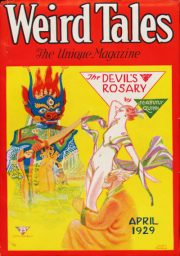 H. P. Lovecraft wrote “The Dunwich Horror” during the summer of 1928. S. T. Joshi states the story is a result of a tour of Athol and central Massachusetts at that time. The story is 17,524 words so about 5,000 more words than “The Colour Out of Space” and 6,500 words more than “The Call of Cthulhu.”
H. P. Lovecraft wrote “The Dunwich Horror” during the summer of 1928. S. T. Joshi states the story is a result of a tour of Athol and central Massachusetts at that time. The story is 17,524 words so about 5,000 more words than “The Colour Out of Space” and 6,500 words more than “The Call of Cthulhu.”
This is part of the cycle of stories set in northern Massachusetts. The fictional village of Dunwich is west of Arkham.
“When a traveler in north central Massachusetts takes the wrong fork at the junction of the Aylesbury pike just beyond Dean’s Corners he comes upon a lonely and curious country. The ground gets higher, and the brier-bordered stone walls press closer and closer against the ruts of the dusty, curving road. The trees of the frequent forest belts seem too large, and the wild weeds, brambles, and grasses attain a luxuriance not often found in settled regions. At the same time the planted fields appear singularly few and barren; while the sparsely scattered houses wear a surprisingly uniform aspect of age, squalor, and dilapidation…No one, even those who have the facts concerning the recent horror, can just what is the matter with Dunwich; though old legends speak of unhallowed rites and conclaves of the Indians, amids twhich they called forbidden shapes of shadow out of the great rounded hills, and made wild orgiastic prayers that were answered by loud crackings and rumblings from the ground below.”
“The Dunwich Horror” is told in third person, something unusual for Lovecraft. The first chapter is description of the Dunwich countryside. Chapter 2 concerns the birth of Wilbur Whateley, son of albino Lavinia Whateley, and grandson of Old Whateley. The son is unusual for growing far beyond that of normal humans. The Whateley’s are a branch called the “decadent Whateleys.” The inhabitants of the area are prone to degeneration. Young Whateley is described as “dark, goatish-looking.”
The denizens of Dunwich hear mysterious hill noises. The Whateley’s engage in some sort of rites on Sentinel Hill the eves of May 1st and November 1st. The dogs of the neighborhood hate Wilbur Whateley.
Old Whateley dies with a large number of whippoorwills that congregated on the property. Lovecraft never does explain the presence of the whippoorwills. I had forgotten about them. Obviously, this is where Robert E. Howard got the idea for the pigeons from hell.
Lavinia Whately disappears with no trace. Wilbur travels to Miskatonic University to borrow the university library’s copy of the Necronomicon. He needs to check on a spell on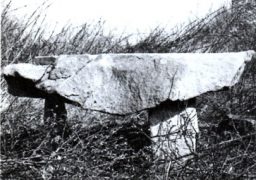 the 751st page. Librarian Dr. Armitage wisely stops that act. Wilbur later attempts a library burglary but foiled by a watch dog.
the 751st page. Librarian Dr. Armitage wisely stops that act. Wilbur later attempts a library burglary but foiled by a watch dog.
Wilbur turns out to be only part human.
“Below the waist, though, it was the worst; for here all human resemblance left off…The skin was thickly covered with course black fur, and from the abdomen a score of long greenish-gray tentacles with red sucking mouths protruded limply…On each of the hips, deep set in a kind of pinkish, ciliated orbit, was what seemed to a rudimentary eye.”
Chapter VII has the real Dunwich horror. A huge invisible creature rampages the township killing livestock and eventually people. It travels back and forth from Cold Spring Glen to Sentinel Hill. Lovecraft goes overboard with some local dialect in a few paragraphs that are irritating.
Librarians come to the rescue. Or rather Dr. Armitage, Professor Rice, and Dr. Morgan. Armitage memorized a formulae to deal with the “mountainous blasphemy.” The three intrepid college professors climb Sentinel Hill while the locals watch through a telescope. One of the locals describes the creature after Rice sprays the horror with a powder to make it visible.
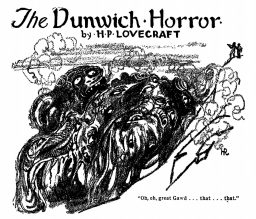 It is described as bigger than a barn, dozens of legs, does not appear to be solid made of jelly with ten or twenty mouths with a semi-human face on the top.
It is described as bigger than a barn, dozens of legs, does not appear to be solid made of jelly with ten or twenty mouths with a semi-human face on the top.
Armitage is able to utter the formula to destroy the monster. There is some pseudo-scientific mumbo-jumbo that “it has gone back to him in some vague realm or dimension outside our material universe.”
The last line of the story reveals that the creature is Wilbur Whately sibling that looks more like the father.
There are mentions of Yog-Sothoth in the story. From the description of the monster, Yog-Sothoth appears to be some sort of space or rather other dimensional super squid on the lines of Cthulhu.
At the end of the day, the story is a Devil’s Bride plot on the lines of Arthur Machen’s “The Great God Pan.”
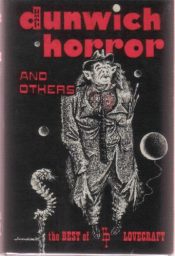 I thought the story was pretty rad when I first read it 34 years ago. I had read no horror outside of Lovecraft at the time. The influences are more noticeable. Lovecraft made use of the Dolmen like structures found around Athol. Instead of using some sort of Biblical demon, he uses a tentacled squiggly. Lovecraft had a sea phobia so his monsters look like sea food. Yog-Sothoth is not even described as an outer space being but other dimensional. I am still trying to figure out where the whippoorwills fit in. If Yog-Sothoth is extra-dimensional, what is causing the underground sounds?
I thought the story was pretty rad when I first read it 34 years ago. I had read no horror outside of Lovecraft at the time. The influences are more noticeable. Lovecraft made use of the Dolmen like structures found around Athol. Instead of using some sort of Biblical demon, he uses a tentacled squiggly. Lovecraft had a sea phobia so his monsters look like sea food. Yog-Sothoth is not even described as an outer space being but other dimensional. I am still trying to figure out where the whippoorwills fit in. If Yog-Sothoth is extra-dimensional, what is causing the underground sounds?
“The Dunwich Horror” appeared in the April 1929 issue of Weird Tales. I am surprised that the generally squeamish Farnsworth Wright took the story. Miscegenation of the nth degree and octopus rape is the basis of the story. Lovecraft was fortunate in having poor competition in that issue of Weird Tales. There was an obligatory Jules de Grandin story by Seabury Quinn, the 2nd part of a lost race story by H. F. Arnold, and a weird western by Drury Sharp.
This story seems to have been very influential on others in the Lovecraft Circle. Robert E. Howard used cosmic squigglies in some of his Conan stories that bear resemblance to the Dunwich Horror.
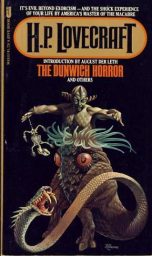
I wouldn’t say that Lovecraft had a sea phobia, although he did loathe the taste and smell of all kinds of seafood. He spent all his life not far from the sea, enjoyed ferry rides, and the one time he was so far out to sea that land wasn’t visible he thought it was a magnificent experience. But his dislike of fish and such was so great that he at least once showed his friends to a restaurant where they could have clam chowder, whereupon he went across the street to have lunch on his own.
I reread this earlier this year for the first time in 15 years or so. I was surprised how little real mystery there is. Everybody in Dunwich pretty much knows what’s up from the outset and Armitage and co. are pretty hip to the malign forces of the universe. Still, the description of Dunwich and its environs are some of HPL’s best scene-setting.
-
Yeah. It reminds me of that Tom Waits song, Cold Cold Ground:
“call the cops on the Breedloves
bring a Bible and a rope
and a whole box of rebel
and a bar of soap
make a pile of trunk tires
and burn ’em all down
bring a dollar with you baby
in the cold cold ground”They knew them Whately’ve been up to no good; some of them have probly been planning for this day for years!
The whippoorwills waiting to catch the souls of the dying comes from folklore (see the “Cultural References” in the Wikipedia article:
https://en.m.wikipedia.org/wiki/Eastern_whip-poor-will
IIRC the whippoorwills in the story were supposed to take the souls of the dead:
“It is vowed that the birds are psychopomps lying in wait for the souls of the dying, and that they time their eerie cries in unison with the sufferer’s struggling breath. If they can catch the fleeing soul when it leaves the body, they instantly flutter away chittering in daemonic laughter; but if they fail, they subside gradually into a disappointed silence.”